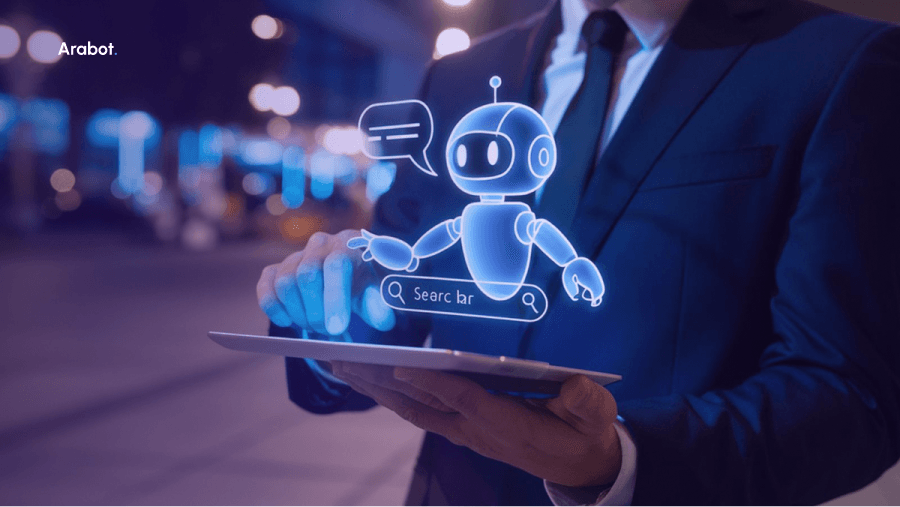AI Automation
How You Can Take Advantage of Customer Intent with The Help of an AI Agent

Customer intent refers to the underlying motivation or need that drives a person's actions, such as searching for information, making a purchase, or seeking assistance. By aligning marketing strategies with customer intent, businesses can deliver more relevant and valuable experiences, leading to increased engagement, conversions, and customer loyalty.
Traditionally, marketers have relied heavily on demographics – age, gender, location, and income – to target potential customers. However, this approach has its limitations. According to Google's research, marketers who solely rely on demographics risk missing more than 70% of potential mobile shoppers.
Understanding Customer Intent
Customer intent is the driving force behind a person's interactions with businesses, including AI chatbots. It can be informational (seeking knowledge or answers), navigational (finding a specific page or feature), transactional (making a purchase or completing a task), or a combination of these intents. For example, a user might ask an AI chatbot "What are the best smart home devices?" (informational intent) or "Help me set up a recurring grocery delivery" (transactional intent).
The context in which a user interacts with an AI chatbot, such as the device they're using, their location, and the time of day, can also provide valuable clues about their underlying intent. For instance, a user asking an AI chatbot "Where is the nearest hardware store?" on their mobile device likely has a different intent than someone asking the same question on a desktop computer.
Research from Google highlights the importance of understanding intent beyond basic demographics:
- Only 31% of mobile searchers for video games are men aged 18 to 34, contradicting the stereotype that video game shoppers are primarily young males.
- 71% of potential video game shoppers would be missed by targeting video ads solely at men aged 18 to 34 on YouTube.
- 40% of baby product purchasers live in households without children, indicating that demographics alone cannot accurately identify potential customers in this market.
These statistics clearly demonstrate that relying solely on demographics can lead businesses, including AI chatbot providers, to miss out on a significant portion of their potential user base. By accurately decoding user intent through natural language understanding and contextual clues, AI chatbots can provide more personalized and relevant experiences, regardless of the user's demographic profile.
The Role of Search and AI in Capturing Customer Intent
Search engines have become powerful tools for decoding customer intent. When people turn to search engines like Google, they are essentially broadcasting their needs and interests through the keywords and queries they use. By analyzing search data and leveraging the insights it provides, businesses can gain a deeper understanding of what their customers are looking for and tailor their marketing efforts accordingly.
Additionally, the rapid advancement of artificial intelligence (AI) and conversational agents (like chatbots and virtual assistants) has opened up new opportunities for businesses to capture and cater to customer intent. These AI-powered solutions can engage in natural language conversations, understand context, and provide personalized assistance based on the user's expressed intent.
The AI-powered solutions mentioned here, including chatbots and virtual assistants, are often referred to as 'AI agents' or 'conversational AI' solutions. AI agents are software programs that can understand natural language, reason, learn, and take actions to assist users in various tasks. Conversational AI, on the other hand, refers to the specific branch of artificial intelligence focused on enabling natural, human-like conversations between humans and machines.
For example, a conversational AI agent integrated into a retailer's website or mobile app can interact with customers, understand their needs and preferences, and provide relevant product recommendations or guidance throughout the shopping journey. By leveraging AI's ability to process and interpret natural language, businesses can deliver intent-driven experiences that feel more human and personalized.
Furthermore, AI can also help businesses analyze large datasets, including search queries, customer interactions, and browsing behavior, to identify patterns and insights that would be difficult for humans to detect manually. This deeper understanding of customer intent can then inform marketing strategies, content creation, and product development efforts.
Strategies for Aligning with Customer Intent:
To effectively align marketing strategies with customer intent, businesses need to adopt a multi-faceted approach. Here are some key strategies to consider:
Being present in the moments that matter
By leveraging search data and insights, businesses can identify the critical moments when potential customers are actively seeking information, solutions, or products related to their offerings. This involves optimizing for relevant keywords, creating engaging content, and ensuring a strong presence across various channels (search engines, social media, etc.) where customers are likely to turn during these "micro-moments."
Creating useful and relevant content
Content plays a crucial role in meeting customer needs and addressing their intent. Businesses should focus on creating high-quality, informative content that directly addresses the queries and pain points of their target audience. This can include blog posts, videos, guides, product comparisons, and more. The key is to provide value and help customers make informed decisions.
Optimizing for micro-moments and delivering seamless experiences
In addition to being present in the moments that matter, businesses must ensure a smooth and cohesive experience across devices and touchpoints. This includes optimizing websites and applications for mobile, providing easy access to relevant information, and enabling seamless transitions between research, consideration, and purchase phases.
Leveraging AI and conversational agents
As mentioned earlier, AI-powered conversational agents can play a significant role in delivering personalized, intent-driven experiences. By understanding natural language and context, these agents can assist customers in real-time, provide relevant recommendations, and guide them through the customer journey based on their expressed needs and preferences.
Case Studies and Success Stories
Several companies have successfully implemented AI-powered conversational agents and intent-based strategies, demonstrating the power of aligning with customer intent. One notable example is the banking industry, where chatbots have been instrumental in providing personalized assistance and addressing customer queries efficiently.
Major banks like Bank of America and Capital One have deployed AI-powered virtual assistants to handle a wide range of customer inquiries, from checking account balances and transferring funds to resolving billing issues and providing personalized financial advice. By leveraging natural language processing and machine learning capabilities, these chatbots can accurately identify the intent behind a customer's query and provide relevant information or initiate the appropriate action.
Customers appreciate the convenience of being able to handle routine banking tasks and receive instant assistance without having to navigate complex menus or wait on hold for a human representative. According to a study by Juniper Research, chatbots in the banking industry are expected to drive cost savings of over $7.3 billion globally by 2023, largely due to their ability to handle high volumes of inquiries efficiently and reduce the need for human intervention in many cases.
These AI agents or conversational AI solutions deployed by banks like Bank of America and Capital One leverage advanced natural language processing and machine learning capabilities to understand customer queries and provide personalized assistance efficiently.
Another compelling example is the e-commerce industry, where chatbots have been instrumental in enhancing the shopping experience and addressing customer needs throughout the buyer's journey. Retailers like H&M and Sephora have implemented AI-powered chatbots that can provide personalized product recommendations, assist with sizing and color selections, and even complete purchases directly within the conversation.
By understanding the customer's intent, whether it's researching products, seeking advice, or making a purchase, these chatbots can provide tailored assistance and relevant information, leading to increased customer satisfaction and sales.
These success stories highlight the power of AI-powered chatbots in delivering intent-driven experiences that not only meet customer needs but also drive tangible business benefits, such as cost savings, increased sales, and improved customer loyalty.
Best Practices and Tips
It's essential to understand and cater to customer intent to provide exceptional user experiences. Here are some best practices and tips to consider:
Leverage natural language processing (NLP) capabilities
AI chatbots and other conversational AI agents excel at understanding and interpreting natural language queries. By employing advanced NLP techniques, these AI agents can accurately identify the intent behind a user's input, whether it's seeking information, making a purchase, or requesting assistance.
Personalize conversations based on intent
Once the user's intent is recognized, the chatbot should adapt its responses and conversational flow accordingly. For example, if a user expresses an intent to purchase a product, the chatbot could seamlessly guide them through the checkout process, provide relevant product recommendations, or offer assistance with sizing or compatibility questions.
Continuously learn and improve
AI chatbots have the ability to learn and improve over time by analyzing user interactions and feedback. By regularly updating the chatbot's knowledge base and conversational models, businesses can ensure that it remains relevant and effective in addressing evolving customer needs and intents.
Integrate with other systems and data sources
To deliver truly personalized and intent-driven experiences, AI chatbots should be integrated with other systems and data sources within the organization. This could include customer relationship management (CRM) systems, product catalogs, inventory databases, and more, allowing the chatbot to access relevant information and provide tailored recommendations.
Prioritize transparency and trust
While AI chatbots offer numerous benefits, it's crucial to maintain transparency and build trust with users. Clearly communicating the chatbot's capabilities and limitations, respecting user privacy, and providing options to escalate to human support when necessary can help establish a positive and trustworthy user experience.
By following these best practices and continuously evolving with the latest advancements in AI and conversational technologies, an AI chatbot website can position itself as a leader in delivering intent-driven, personalized experiences that delight customers and drive business success.
Conclusion
By moving beyond traditional demographic-based targeting and embracing an intent-driven approach, businesses can connect with their customers in more meaningful and effective ways.
The combination of search data insights and the power of artificial intelligence, particularly conversational AI agents like chatbots, has opened up new avenues for businesses to decode customer intent and deliver personalized, relevant experiences. From being present in the moments that matter to creating useful content and leveraging AI-powered assistance, businesses that prioritize customer intent are better positioned to build lasting relationships, drive conversions, and stay ahead of the competition.
Remember, customer intent is not a passing trend but a fundamental shift in how consumers engage with brands. Those who can effectively decode and cater to this intent will be the ones who thrive.
Let arabot's AI solutions platform be your guide. Our advanced conversational AI agents and omnichannel capabilities will help you understand and cater to your customers' intents, no matter where they engage with your brand.
Request a demo today!
© 2025 copyright Arabot. All rights reserved.
 Insurance
Insurance Healthcare
Healthcare Automative
Automative Hospitality
Hospitality Banking
Banking Government
Government Telecommunication
Telecommunication Education
Education Human Resources
Human Resources
